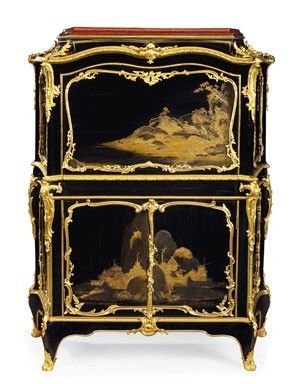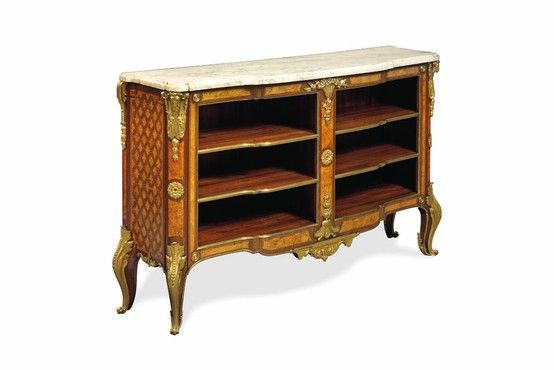Christie's shares remarkable family insights into Djahanguir Riahi, an impassioned collector
Bernard II van Risenburgh (BVRB), A magnificent ormolu-mounted Japanese lacquer secretaire-à-abattant, circa 1755. Estimate: GBP3,000,000–5,000,000. Photo: Christie's Images Ltd 2012.
LONDON.- Ahead of the sale of Masterpieces Formerly in the Collection of Monsieur and Madame Riahi in London on Thursday 6 December, Christie’s shares remarkable family insights into Djahanguir Riahi, an impassioned collector whose focused commitment over 50 years to collect world class 18th century furniture and works of art provides inspiration for connoisseurs around the globe. From placing adverts in the hunt for key missing examples to going in to battle at auction with other leading names in the field of collecting, the tale of Djahanguir Riahi’s collecting epitomizes the lengths that “Passion for the Love of Art” can drive the true collector.
“Collections are alive. They are neither an amalgamation of objects, nor an addition of dates; they are not even a sum of monetary amounts. A collection lives as it is first and foremost the history of a man, of a woman, of a family, of a collector - its creator - the one whose vision, whose particular personality shapes its ensemble, sometimes in a heterogeneous and miscellaneous manner, giving it a life and mind of its own.”
“Djahanguir Riahi is such a man, a creator of collections and one of the most important of the past century. Decade after decade, piece after piece, he has shaped a collection without precedent. As a man enamoured with a past century, it was his eye, passion and the soul of a strategist that helped him conquer and build an outstanding and beautiful collection of 18th century French furniture.”
“La notion de Chef d’Oeuvre”
“To begin with, there was a man, a Persian child who became a great industrialist, an immigrant who became French at heart. At the start, there was a name, coming from Iran, a name that became symbolic of taste and success in Paris during the „Glorious Thirty‟ (1945-75).”
“Djahanguir Riahi and his collection are one. The story of this collection is the story of symbiosis - an encounter between a unique eye and the masterpieces amidst a crowd, an encounter between the most beautiful pieces of furniture from 18th century France and the man who reinstated their lustre from the past.”
“Djahanguir Riahi identified 18th century French furniture as a „moment de grâce‟ within the history of art, a moment during which Man‟s creative Genius was at its peak.”
“Queen of Arts, the Marquise de Pompadour ”
“Most likely the mother of all masterpieces, the magnificent ormolu-mounted Japanese lacquer secretaire-à-abattant, circa 1755 by Bernard II van Risenburgh (BVRB) (estimate: £3 million to £5 million) is recorded in the journal of Duvaux, 19 February 1757. The only other secrétaire of this model by BVRB in Japanese lacquer - of an identical form and sharing most of the ormolu mounts - is the extremely closely related secrétaire (now lacking its apron mount) in the Royal Collection at Windsor Castle. Supplied by the marchand Simon-Philippe Poirier (and bearing his trade label on a drawer) the Royal Collection secrétaire was acquired by the Duchesse de Mazarin and was part of her collections at the hôtel de Seignelay until it was sold in her sale of 1781. It was purchased by the marchand Lebrun but subsequently changed hands until it was acquired by the dealer Benoist for George IV in 1820. That Mme. de Pompadour‟s secrétaire was supplied by Duvaux, who was a contemporary rival of Poirier, is seen to prove almost categorically that Mme. De Pompadour‟s secrétaire and the Riahi secrétaire are one and the same.”
“The term masterpiece starts to make sense when looking at the purity and line of the ormolumounted Japanese lacquer secretaire-à-abattant and the Louis XV ormolu-mounted Japanese lacquer and vernis martin bureau en pente, attributed to Bernard II van Risenburgh (BVRB), circa 1756, which was also almost certainly supplied by Duvaux to Madame de Pompadour (1721-1764) on 22 December 1756 (estimate: £2 million - £4 million).”
“More than simply pieces of furniture, these two works are true gems of all time.”
“Rothschild Provenance”
The Rothschilds have been the greatest collectors of superlative French 18th century Decorative Arts throughout many generations. The Riahi Collection was the finest private collection of this type to be assembled in the 20th century and it is fitting that this sale presents six significant pieces with Rothschild provenance some threads of which have only recently been traced, shedding new light on the historical importance of these works of art, such as the rare Louis XVI ormolu-mounted polychrome-painted mahogany and sycamore meubles d'entre deux attributed to Ferdinand Bury, the decoration attributed to JeanLouis Prevost, circa 1775-1790, possibly retailed by Jean-Baptiste II Tuart (estimate: £300,000-500,000), which were purchased in 1977 by Riahi for his living room.
Further lots with Rothschild provenance include one of only two library commodes from the era of Louis X known to this day, produced circa 1763-68 by Jean-François Oeben (estimate : £1.5 million - £2.5 million). This piece is offered with newly discovered Viennese Rothschild provenance, having most likely been part of the collection of Baron Nathaniel Meyer von Rothschild (1836-1905).
“A tale of Battles, Kings and Titans of Collecting”
“Self-made man Djahanguir Riahi knew how to transpose his business skills when negotiating the purchase of works that he sought. His collection speaks of war, kings and competing with other titans of collecting; of the ensuing victory, beauty, the absolute!”
“The collection represents the remnants of an era, all of which carry the history of those who had previously owned them.” “In order to acquire certain works, the collector had to strategize and deliver Homeric battles against other legendary collectors of the 20th century, including Getty, Niarchos, Onassis, Rockefeller and Gulbenkian.”
“As such, the pot-pourri de Tallard (lot 3, estimate: £250,000 - 400,000), acquired in 1973, was an object very much desired by Onassis, who offered his rival a blank cheque in exchange of its acquisition. But to Riahi, certain objects had no price, and once in his possession, could no longer be sold.”
“The near pair of Louis XV ormolu-mounted Japanese and Chinese lacquer commodes attributed to Bernard II van Risenburgh or Jean Desforges, circa 1740-50, possibly supplied by Charles Darnault tell a remarkable tale of acquisition via ingenious strategy (lot 40, estimate: £2 million- 4 million). 12 years prior to purchasing the Chinese lacquer commode, Djahanguir Riahi had purchased a similar Japanese lacquered commode from the collection of Baron Stieglitz which had been dispersed by the Soviet government in Berlin between 1928 and 1930. Obsessed with symmetry, upon discovering the existence of the Chinese lacquer commode ahead of its planned sale at Druot, Riahi knew that it must be united with the Japanese lacquer commode he already owned. Fearing that billionaire Stavros Niarchos would also want to acquire this piece, Djahanguir Riahi did not hesitate, contacting the buyer directly and successfully purchasing it just three days before its sale at auction in Paris.”
“50 Years in the Making”
“Riahi‟s love of symmetry encouraged him to acquire objects in pairs. Pragmatic in his approach, Djahanguir would often post adverts in the relevant newspapers and specialist art publications to find the missing twin of a specific treasured object.”
“Djahanguir Riahi loved the idea of reuniting objects and pieces of furniture that had been separated over time, in the course of revolutions or wars. Examples of works that he was able to reunite include: the famous pair of lacquered commodes previously detailed (lot 40); two small marquetery tables (which lot?), a near pair of céladon vases (lot 14, estimate: £400,000-600,000), a pair of pair of Louis XV ormolu threebranch wall-lights, attributed to Jean-Claude Duplessis, circa 1745-55 (lot 22, estimate: £150,000-250,000) and two chandeliers: a Louis XIV ormolu six-light chandelier attributed to André-Charles Boulle, circa 1700-10 9lot 10, estimate: £400,000 - 600,000) and a restoration ormolu six-light chandelier circa 1830-40, after the design by André-Charles Boulle (lot 11, estimate: £30,000-50,000).”
“A Stellar group of Silverware”
“The extraordinary reunion of a suite of 28 silver candlesticks by Lenhendrick (lot 46, estimate: £1 million to £2 million) is the result of Djahanguir Riahi chasing pair by pair, sale after sale, over a 50 year period – providing a remarkable illustration of the collector‟s tenacious hunt for treasures.”
“The group of silverware is worthy of Royalty. Never has such a group of French silverware been presented at auction, with 4 soup tureens, stands and liners (lots 33 and 35), with ram heads, by Robert Joseph Auguste, silversmith for King Louis XVI.”
Further silverware highlights include a pair of Louis XV silver dish-covers and a pair of Russian silver dishes from the Orloff service - which was commissioned by Queen Catherine of Russia for Count Orloff - the dishcovers with the mark of Jacques Nicolas Roettiers, Paris, 1771, one dish with the mark of Johan Heinrich Blohm, St. Petersburg, 1782, the other apparently unmarked, circa 1782 (lot 31, estimate: £150,000-250,000).
“Objects as gems, symbolic of Love”
“Djahanguir Riahi saw himself as a pearl-fisher, criss-crossing the oceans to find the perfect „gem‟ that would complete a unique „necklace‟, which his visionary eye patiently created with the tenacity of a treasure hunter. This analogy goes beyond the simple anecdote. Indeed, Riahi considered each piece that he searched as a precious jewel.”
“He would often present these jewels as gifts to his wife. During Christmas in 1963, although he had only recently met her, he purchased a superb bureau plat by Joseph Baumhauer, circa 1765 (lot 30, estimate: £2 million to £3 million), a gem he considered to be the epitome of elegance and purity of line.”
“What would an epic story be without the love of a woman? The collector‟s search for perfection was also pushed by the love he had for his wife.”
“For his wife, Riahi demanded only the best works, with the best provenance: Objects of royal quality for his queen. As such, he presented her with the pair of Orloff silver dishes with covers (lot 31), the Auguste soup tureens (lots 33 and 35), and le secrétaire en pente which had formerly belonged to the Marquise de Pompadour (lot 20).”
“A Persian name forever engraved in the History of Art”
“More than a carefully selected group of masterpieces, this collection is itself a masterpiece, and as such, rendered the collector famous beyond his native country.”
“Between the rooms of Marie Antoinette and Rothschild, The Louvre now dedicates a room to Riahi. This is without a doubt the most powerful tribute that France could have given its adoptive son. This room displays a variety of donations made by the collector: a stellar médailler Louis XIII, a porcelain vase-ballon de Sèvres and a pair of porcelain cuvettes „Mahon‟ de Sèvres.”
“Commandeur of the Légion d‟Honneur and Commandeur des Arts et des Lettres, he was friends with Georges Pompidou, Valéry Giscard d‟Estaing and Jacques Chirac, and acted as a consultant to the conservateurs of great French museums such as the Louvre, Versailles and the Rohan Palace.”
“All the greatest 18th century French furniture experts maintain that the RIAHI collection is worthy of the Louvre or Versailles, and, as described by M. Alcouffe, chief conservator of the Louvre: „this is an immense œuvre composed of an ensemble of works that were impressively gathered in our era.‟”
“In terms of 18th century French furniture, the name Riahi is more than a reference; it is a model, a name which will never cease to exist as a synonym with excellence, perfection and taste.”
Jean François Oeben, Ormolu-mounted amaranth and burr-walnut bibliothèque en commode, circa 1760. Estimate: GBP1,500,000–2,500,000. Photo: Christie's Images Ltd 2012.

/https%3A%2F%2Fprofilepics.canalblog.com%2Fprofilepics%2F1%2F0%2F100183.jpg)
/https%3A%2F%2Fstorage.canalblog.com%2F03%2F02%2F119589%2F96711876_o.jpg)
/https%3A%2F%2Fstorage.canalblog.com%2F11%2F31%2F119589%2F94773502_o.jpg)
/https%3A%2F%2Fstorage.canalblog.com%2F20%2F83%2F119589%2F94772815_o.jpg)
/https%3A%2F%2Fstorage.canalblog.com%2F26%2F72%2F119589%2F75604929_o.jpg)
/https%3A%2F%2Fstorage.canalblog.com%2F59%2F60%2F119589%2F26458628_o.jpg)




/http%3A%2F%2Fstorage.canalblog.com%2F06%2F21%2F119589%2F111534125_o.jpg)
/http%3A%2F%2Fstorage.canalblog.com%2F76%2F50%2F119589%2F111370157_o.jpg)
/http%3A%2F%2Fstorage.canalblog.com%2F03%2F11%2F119589%2F95298688_o.jpg)
/http%3A%2F%2Fstorage.canalblog.com%2F59%2F51%2F119589%2F93829216_o.jpg)